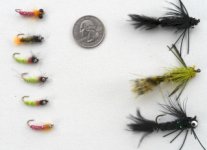F
Fishidiot
Active member
- Joined
- Sep 9, 2006
- Messages
- 9,960
Redbreast sunfish are a summer favorite for small stream FFers in Pa – or if they’re not, they ought to be. Redbreasts have saved many days for me when bass wouldn’t cooperate. Sometimes I target them deliberately and consider smallies to be incidental catches on those days. Among my favorite rivers for RBS is the Raystown Branch of the Juniata. As you scout out bass creeks, you’ll often find some that are just terrific RBS fisheries and, hopefully, you’ll come to have some favorite RBS creeks of your own. They hang out in many of the same streams and in essentially the same habitat as smallies: chunk rocks in mid river current often hold RBS, esp larger ones. Smaller RBS are often hanging out along the shoreline over sandy flats and woody cover. They’re in lakes too but much prefer creeks and rivers – which is where I prefer to fish myself. Anyway, when I’m bassin and things are slow, I’ll typically put a small nymph as a dropper behind a larger bass nymph. In my experience, RBS, even large ones over 6 inches, prefer smaller flies. Their mouths are bigger than bluegills and almost as large as green sunfish but they seem to prefer smaller flies than greenies and certainly smaller than rock bass prefer. I get a few on poppers or streamers from time to time but, in my experience, if you want to slay the RBS, you need to downsize and fish subsurface. Here’s my setup: tie on a large, heavy bass fly (the big ones on the right in the pic, for example) and then drop the smaller RBS nymph about a foot behind it or as a point fly. I actually tie my big bass nymphs with a wire eyelet back at the bend of the hook to make this easier. This eyelet is visible in the big, lower nymph if you look closely. For the RBS, they’re not picky when it comes to patterns. As a rule, for RBS nymphs I like narrow profile flies tied in bright colors. They need to be durable. You’re likely to catch a lot of fish on a single fly and will often need to use hemostats to get the hooks out of their small mouths (sunnies take flies deep!) and your flies will really take a beating. I don’t bother with hackle or legs or similar stuff as it just gets destroyed when you’re catching fish after fish. Use longer shank hooks as this will also make it easier to get the fly out of their mouth. The flies on the left are typical examples of my RBS nymphs: small (about 1”), narrow, bright colored, and durable. Fish this combo dead drift under an indicator. SMBs and rock bass will (usually) grab the big nymph, while RBS will get the little one. Often, when you’re having a blast catch sunnies you’ll be pleasantly surprised to get a nice bass (or a bunch of them) when fishing this combo, or something similar.
Now is prime time to wade a small creek and catch a mess of redbreast sunfish. They’re great fun.
Now is prime time to wade a small creek and catch a mess of redbreast sunfish. They’re great fun.





